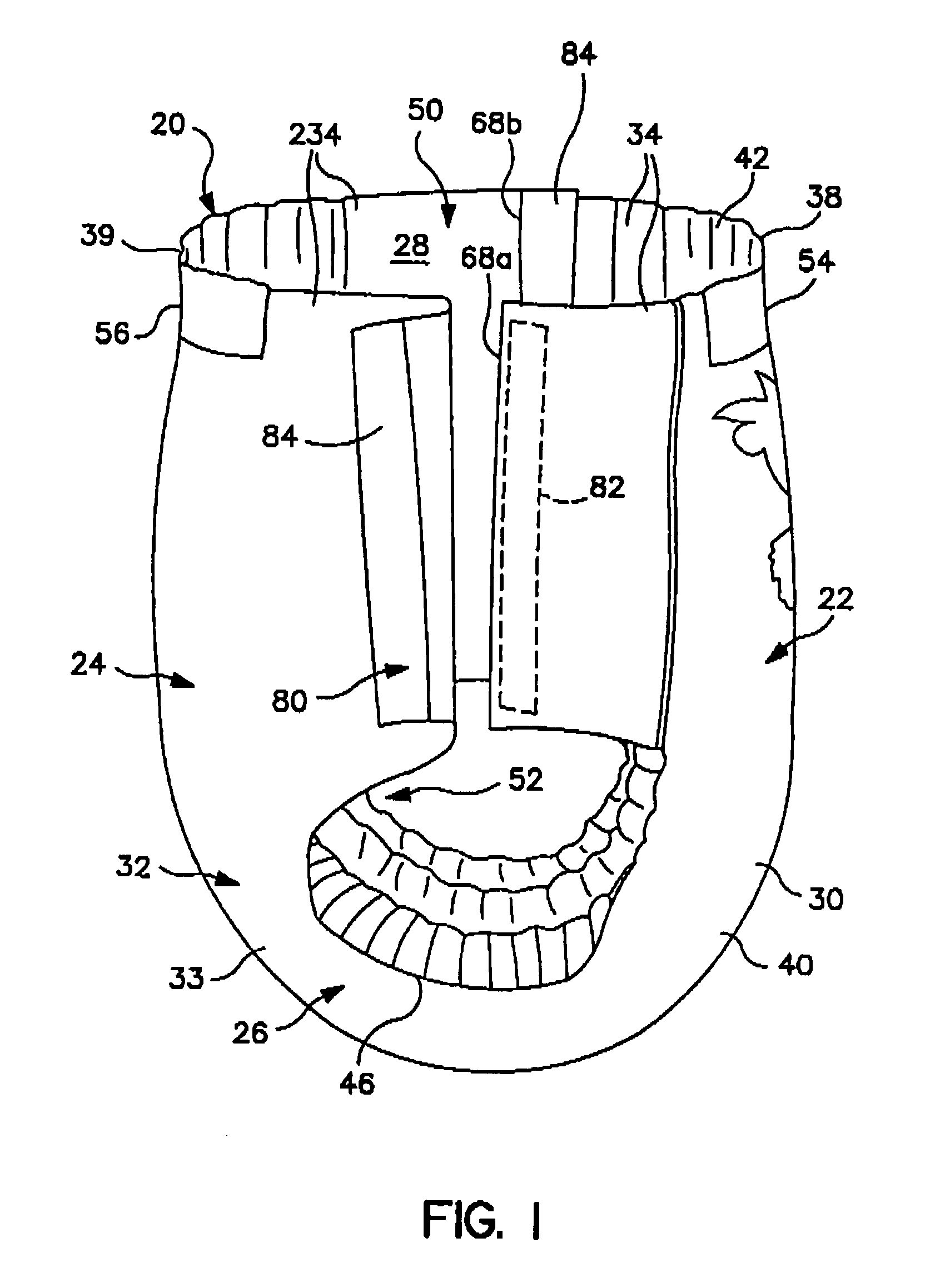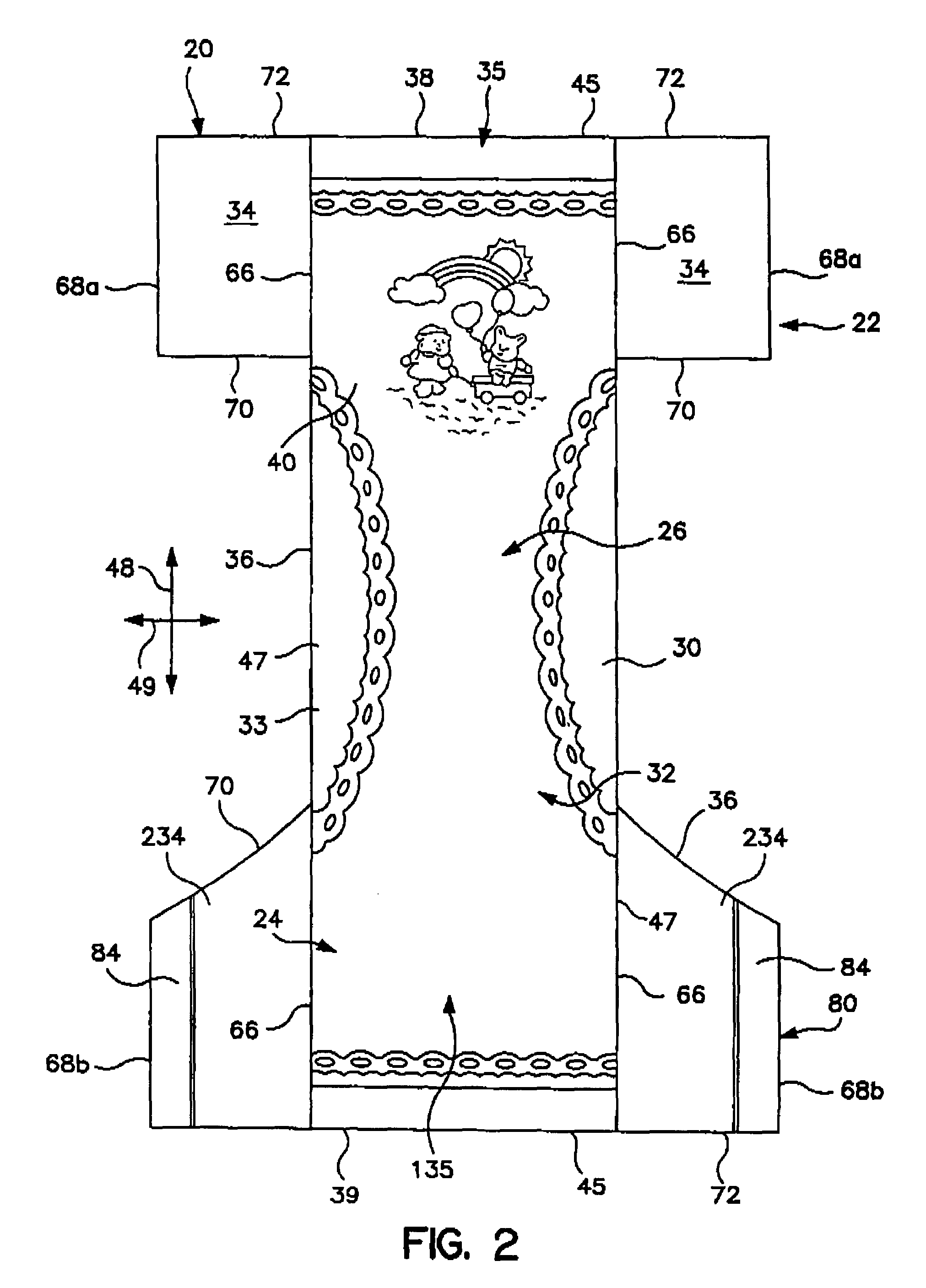Thin, flexible, low capacity absorbent article with leakage protection
a technology of absorbent articles and leakage protection, applied in the field of absorbent articles, can solve the problems of low capacity training pant overflow and create a situation with consequences, and achieve the effects of low absorbent capacity, low probability of leakage, and low capacity
- Summary
- Abstract
- Description
- Claims
- Application Information
AI Technical Summary
Benefits of technology
Problems solved by technology
Method used
Image
Examples
example 1
[0089]One example of a prototype product designed to handle a single void volume of 100 cc at a flow rate of 15 cc / sec while a wearer is in a standing position includes 5.2 g of a 3000255 EAM NOVATHIN® composite with a 0.5 psi saturation capacity of 23 g / g. The EAM composite is placed in the target zone, i.e., crotch area, of a training pant prototype based on or similar to a PULL-UPS® Training Pant with the absorbent removed and a different absorbent in its place. A high intake surge, 50 gsm 6 denier PET / 3 denier bicomponent binder fiber is placed over the composite in the target zone. A caliper (in the front) of the finished product under 0.2 psi load is about 2 mm. The pant is constructed and sized to take advantage of the low mass, thin absorbent.
example 2
[0090]A single-insult prototype pant was produced having an absorbent system including a 102 mm by 385 mm piece of 2000155 EAM NOVATHIN® absorbent composite with a 50 gsm 6 denier polyethylene terephthalate (PET) / 3 denier bicomponent binder fiber surge placed over the composite in the target zone and a 0.5 osy spunbond liner also placed over the composite. Full product thickness was 2.5 mm. This product had a 0.5 psi saturation capacity of 150 ml. The occurrence of runoff in this product was assessed with a Single Insult test, described in detail below, using 60, 80 and 100 ml of 0.9% NaCl saline at 5 ml / sec. The flaps and leg elastics were removed in this static cradle test. Results are shown in Table 1. When insulted with 60 ml of physiological saline there was no runoff. Runoff increases with insult volume, as shown.
[0091]
TABLE 1Single Insult Test of Example 3 Insulted with 0.9% NaCl SalineSaline (ml)SampleDry Weight (g)Bulk (mm)Runoff (g)60121.632.43None221.712.60None321.582.44N...
example 3
[0093]A single-insult prototype pant was produced with a 102 mm by 385 mm piece of an online UTA targeting a 0.5 psi saturation capacity of 150 ml. The online UTA contained 3.7 g of FAVOR® SXM 9543 SAP and 3.7 g of NB416 pulp fiber. The UTA pad was 100 mm by 385 mm and approximately 0.8 mm thick. This absorbent pad was incorporated into a PULL-UPS® Training Pant in place of the existing absorbent pad. Full product thickness was 2.8 mm. The occurrence of runoff in this product was assessed with a Single Insult Test, described in detail below, using 60, 80 and 100 ml of 0.9% NaCl saline at 5 ml / sec. The flaps and leg elastics were removed in this static cradle test. Results are shown in Table 2. As in the previous example, when insulted with 60 ml of physiological saline there was no runoff. Runoff increases with insult volume, as shown.
[0094]
TABLE 2Single Insult Test of Example 3 Insulted with 0.9% NaCl SalineSaline (ml)SampleDry Weight (g)Bulk (mm)Runoff (g)60122.752.86None223.492.7...
PUM
 Login to View More
Login to View More Abstract
Description
Claims
Application Information
 Login to View More
Login to View More - R&D
- Intellectual Property
- Life Sciences
- Materials
- Tech Scout
- Unparalleled Data Quality
- Higher Quality Content
- 60% Fewer Hallucinations
Browse by: Latest US Patents, China's latest patents, Technical Efficacy Thesaurus, Application Domain, Technology Topic, Popular Technical Reports.
© 2025 PatSnap. All rights reserved.Legal|Privacy policy|Modern Slavery Act Transparency Statement|Sitemap|About US| Contact US: help@patsnap.com



